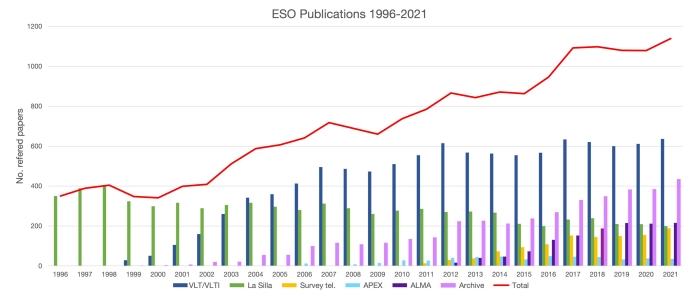Last year proved to be a record-breaking year for research based on observations conducted at ESO observatories. A recent report by the ESO Library and Information Centre shows that, in 2021 alone, over 1100 papers including ESO data were released, the highest annual number of publications from ESO telescope data to date.
Record Number of Studies Using ESO Data Published in 2021

The most significant contribution to these publications comes from ESO’s Very Large Telescope (VLT), and the VLT Interferometer (VLTI), which yielded data included in over 600 studies. The Multi Unit Spectroscopic Explorer (MUSE) continues to be one of the most productive VLT instruments, providing data for over 160 articles in 2021. There has also been a steep increase in papers using data from the VLTI instrument GRAVITY this year. Highlights from these facilities include the discovery, using MUSE, of the closest pair of supermassive black holes to date and investigations into the causes of Betelgeuse’s great dimming, which relied on GRAVITY data as well as observations from the VLT’s SPHERE instrument.
Data from the survey telescopes at ESO’s Paranal Observatory in northern Chile, the Visible and Infrared Survey Telescope for Astronomy (VISTA) and the VLT Survey Telescope (VST), led to almost 190 published papers in 2021, an increase on previous years. Approximately half of these papers (46%) used data obtained from the ESO Science Archive, emphasising the value of ESO’s public surveys for the astronomy community at large.
In 2021, the Atacama Large Millimeter/submillimeter Array (ALMA), in which ESO is a partner, provided data for more papers than ever before. Similarly to last year, 45% of them (or over 210 studies) used data obtained during European ALMA time. An example includes a paper reporting on powerful stratospheric winds measured on Jupiter for the first time, published in March 2021.
ESO is also a partner in the Atacama Pathfinder Experiment (APEX), which is located near ALMA on the Chajnantor plateau in Chile’s Atacama region. In 2021, observations obtained during ESO observing time at APEX contributed to 35 papers, more than half (57%) of studies from all APEX observing time.
As in previous years, observations obtained at the La Silla facilities led to approximately 200 papers. Data from instruments that were decommissioned years ago still actively contribute to the pool of data papers.
The number of papers that partly or exclusively use archival data has increased continuously during recent years, reaching 38% of the total number of studies in 2021. Almost a quarter of all papers published in 2021 (23%) used only archival ESO observational data. This highlights that past observations continue to be used by astronomers and lead to further breakthroughs in science.
These record-breaking publication numbers highlight ESO’s important role in helping astronomers advance our understanding of the Universe.
The statistics presented here are derived from telbib, a database of refereed papers published by the ESO users community. Telbib links publications with the data in the ESO Science Archive and assists the ESO Management with evaluating the Organisation’s productivity and impact. Telbib is curated and developed by the ESO Library and Information Centre While text-mining scripts are applied when screening the literature for ESO data papers, articles are carefully examined by the curators before they are added to the database to ensure that all telbib papers use partly or exclusively data from facilities for which observing time was recommended by ESO.
The ALMA bibliography is maintained jointly by the librarians at ESO and the National Radio Astronomy Observatory (NRAO) in the USA as well as by the National Astronomical Observatory of Japan (NAOJ). Publications based on data from all ALMA partners are recorded in telbib, but only those based on European observing time are counted in the ESO statistics, unless otherwise noted.
